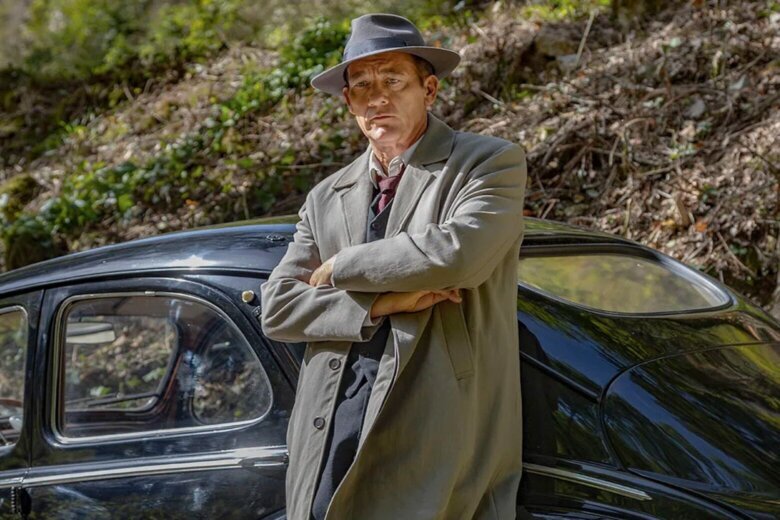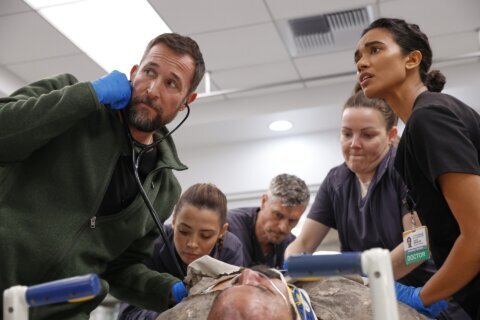
In 1941, Humphrey Bogart played Detective Sam Spade in John Huston’s film noir masterpiece “The Maltese Falcon,” ranked by the American Film Institute as the No. 6 mystery film of all time.
Now, Clive Owen dons the fedora in the new six-episode miniseries “Monsieur Spade,” a neo noir co-production between U.S. cable network AMC and French streaming service Canal+ that airs Episode 3 this Sunday night.
Set decades later in 1963, Spade is no longer a hungry private eye in San Francisco but rather a seasoned retiree smoking and swimming in the quiet town of Bozouls in the South of France. That changes when six beloved nuns are killed at a local convent, all while Spade is tasked with transporting a tough, young girl named Teresa, daughter of Brigid O’Shaughnessy, the femme fatale famously played by Mary Astor in “The Maltese Falcon.”
Before you say, “How dare they reboot Sam Spade!” just remember that the 1941 classic “The Maltese Falcon” is itself a remake of the lesser-known 1931 film starring Ricardo Cortez and Bebe Daniels. Both are based on the 1930 mystery novel “The Maltese Falcon” by Dashiell Hammett (a Maryland native!), so originality isn’t a prerequisite for your enjoyment of this classic character from landmark literature and Hollywood history.
What is a little odd is having a British actor playing such an iconic American. It’s hard to top Bogie, but Owen did earn an Oscar nod for “Closer” (2004) and an Emmy nod as Ernest Hemingway in “Hemingway & Gellhorn” (2012). I guess we can roll with the casting since the British gave us “The Third Man” (1949), while the setting reminds us that film noir was coined by the French for banned American films suddenly available after liberation from Nazis.
Come to think of it, this new setting of a freshly liberated France is fitting because many of Bogart’s most famous roles were associated with the region. Twice he helped French resistance fighters battle the Nazi-allied Vichy government, running guns in the French colony of Martinique in “To Have and Have Not” (1944) and nodding for Victor Laszlo to sing “La Marseillaise” in “Casablanca” (1942), arguably the greatest scene in all of movie history.
No, you won’t find Peter Lorre or Sydney Greenstreet, but “Monsieur Spade” showrunners Scott Frank and Tom Fontana pay constant homage to “The Maltese Falcon.” In Episode 1, Spade references his late partner in crime Miles Archer: “Paid to meddle, as Miles used to say.” He also recalls Brigid O’Shaughnessy’s fate with elevator gates closing on her face like jail bars: “I sent her mother to rot in prison and her father to die in Algeria.”
Beyond the callbacks, there’s also great hardboiled dialogue with snappy lines: “A long time ago someone once said to me, ‘Money and gratitude don’t always go hand and hand.'” My favorite bit of writing is a monologue in Episode 1, with so many clever turns of phrases that it could have been ripped straight from a 1940s screenplay:
“People come to you with their problems and you end up inheriting those problems, but you’re good at fixing them, so the problems keep coming — along with the money. In a very short while, the problems go from small to deadly. Turns out, you’re good at those too, maybe too good. One day you wake up, you look in the mirror and you see someone you don’t much like. No big deal, just don’t look in the mirror anymore. The money and the drink are a nice distraction until you finally rot from the inside all the way out and no matter how much you drink or how much money you make, you can never get away from your own stink.”
The writing is so sharp that it’s no surprise that Fontana wrote for NBC’s “Homicide: Life on the Street” (1993-1999) and created HBO’s “Oz” (1997-2003), while Frank wrote Oscar-nominated scripts for Steven Soderbergh’s “Out of Sight” (1998) and James Mangold’s “Logan” (2017) before creating Netflix’s “The Queen’s Gambit” (2020).
Together, they co-write all six episodes of “Monsieur Spade,” which Frank patiently directs with ominous shots of car headlights like “Chinatown” (1974), the greatest neo-noir ever made. Composer Carlos Rafael Rivera (“The Queen’s Gambit”) echoes Jerry Goldsmith’s score with themes of exposing society’s underbelly, but instead of Noah Cross diverting water, we get the bloody crosses of slain nuns like Netflix’s docuseries “The Keepers” (2017).
If Episode 1 hooks us with a killer cliffhanger, Episode 2 starts to answer our most burning questions, revealing that Teresa was a witness to the murders, seeing and hearing clues through a cracked door — and delivering an awesome line about where she left her knife (I laughed out loud). We also learn that the killings are somehow connected to a mysterious, maybe even mystical young boy who is believed to possess paranormal powers.
I’m not sure why supernatural elements are invading our gritty detective shows lately — Jodie Foster is dealing with the same thing in Season 4 of HBO’s “True Detective” — but I’m here for the ride to see if Sam Spade can crack the case before lung cancer cracks him. I suppose gum still sticks to supernatural shoes. After all, it was Spade who shirked tangibility when handling a phony bird statue: “The, uh, stuff that dreams are made of.”
Get breaking news and daily headlines delivered to your email inbox by signing up here.
© 2024 WTOP. All Rights Reserved. This website is not intended for users located within the European Economic Area.









